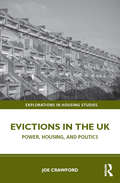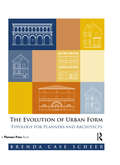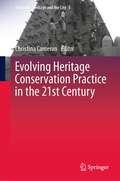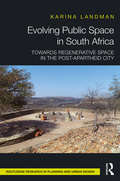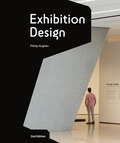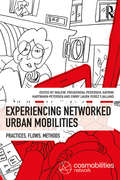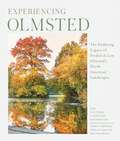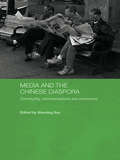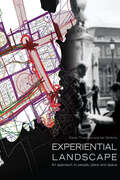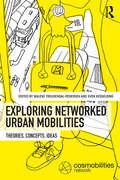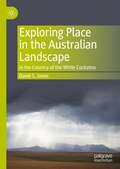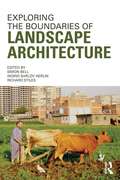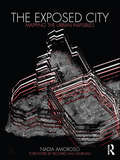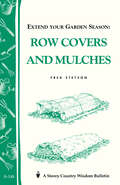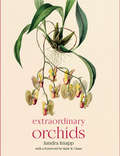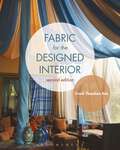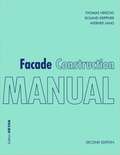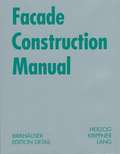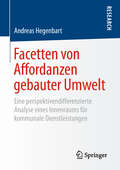- Table View
- List View
Evictions in the UK: Power, Housing, and Politics (Explorations in Housing Studies)
by Joe CrawfordEvictions in the UK examines the relationships between tenants, landlords, housing providers and government agencies and the tensions and conflicts that characterise these relations. The book shows how power dynamics are being reconfigured in the post-welfare context of the first quarter of the 21st century, as evictions for rent arrears are becoming one of the most significant threats to both the wellbeing of the social housing sector and the welfare of its tenants. Embracing both practical and critical approaches, this book offers a comprehensive understanding of the contradictory and thus controversial issue of evictions. It explores the range of perspectives involved in the practice – landlords carrying out evictions, those agencies providing legal assistance to evictees, as well as academics and institutions charged with researching and regulating the process. Drawing on three case studies relating to evictions across Scotland and England, this book provides a comprehensive look at the punitive consequences of poverty (evictions for rent arrears) and status (evictions under immigration law) that are applicable to social housing systems worldwide. Based on original, primary-source data, this book will be a key resource for academics and students as well as policy makers and practitioners in the fields of housing studies, planning, social welfare, and political sociology.
The Evolution of Urban Form: Typology for Planners and Architects
by Brenda Case ScheerWhy are so many of our urban environments so resistant to change? The author tackles this question in her comprehensive guide for planners, designers, and students concerned with how cities take shape. This book provides a fundamental understanding of how physical environments are created, changed, and transformed through ordinary processes over time. Most of the built environment adheres to a few physical patterns, or types, that occur over and over. Planners and architects, consciously and unconsciously, refer to building types as they work through urban design problems and regulations. Suitable for professional planners, architects, urban designers, and students, This book includes practical examples of how typology is critical to analytical, design, and regulatory situations.
The Evolution of Urban Form: Typology for Planners and Architects
by Brenda Case ScheerWhy are so many of our urban environments so resistant to change? The author tackles this question in her comprehensive guide for planners, designers, and students concerned with how cities take shape. This book provides a fundamental understanding of how physical environments are created, changed, and transformed through ordinary processes over time. Most of the built environment adheres to a few physical patterns, or types, that occur over and over. Planners and architects, consciously and unconsciously, refer to building types as they work through urban design problems and regulations. Suitable for professional planners, architects, urban designers, and students, This book includes practical examples of how typology is critical to analytical, design, and regulatory situations.
Evolving Heritage Conservation Practice in the 21st Century (Creativity, Heritage and the City #5)
by Christina CameronThis book focuses on current trends in cultural heritage conservation and their influence on heritage practice. Seen through the lenses of World Heritage, historic urban landscapes, heritage tourism, climate change or the nature/culture nexus, these challenges call for innovative approaches to protect and conserve our heritage places. The book brings together the voices of different stakeholders in the heritage conservation process, ranging from scholars, site managers and government officials to young professionals and students.
Evolving Public Space in South Africa: Towards Regenerative Space in the Post-Apartheid City
by Karina LandmanEvolving Public Space in South Africa discusses the transformation of public space highlighted in the country. Drawing on examples from major cities, the author demonstrates that these spaces are not only becoming wasted space, but are also adapting and evolving to accommodate new users and uses in various parts of the city. This process of evolution tends to challenge the more traditional visions and general global views of declining public space in cities and argues that it rather resembles the resilience of these spaces and the potential for regeneration through continuously emerging and mutating forms, functions and meanings. Including over 20 black-and-white images, this book would be beneficial to academics and students of urban planning and design and those interested in the regeneration of cities.
Evolving Public Space in South Africa: Towards Regenerative Space in the Post-Apartheid City
by Karina LandmanEvolving Public Space in South Africa discusses the transformation of public space highlighted in the country. Drawing on examples from major cities, the author demonstrates that these spaces are not only becoming wasted space, but are also adapting and evolving to accommodate new users and uses in various parts of the city. This process of evolution tends to challenge the more traditional visions and general global views of declining public space in cities and argues that it rather resembles the resilience of these spaces and the potential for regeneration through continuously emerging and mutating forms, functions and meanings. Including over 20 black-and-white images, this book would be beneficial to academics and students of urban planning and design and those interested in the regeneration of cities.
Exhibition Design Second Edition: An Introduction
by Philip HughesExhibition Design describes the skills needed to become an exhibition designer, including: developing a brief and working with clients; design principles for graphics, circulation, lighting, and accessibility; presenting ideas to clients; and the practicalities of production. A wealth of visual material includes photographs of completed exhibitions by world-renowned designers, concept drawings, computer renderings, charts and tables of information – all for a wide range of exhibitions around the world, permanent and temporary, including museums and galleries, visitor centres, brand experiences, festivals, and trade fairs. This second edition includes new examples, updated information on the latest digital technology, and expanded coverage of interactives and sound and film.
Experiencing Networked Urban Mobilities: Practices, Flows, Methods (Networked Urban Mobilities Series)
by Malene Freudendal-Pedersen Katrine Hartmann-Petersen Emmy Laura Perez FjallandExperiencing Networked Urban Mobilities looks at the different experiences of networked urban mobilities. While the focus in the first book is on conceptual and theory-driven perspective, this second volume emphasizes the empirical investigation of networked urban mobilities. This book is a resource for researchers interested in the field to gain easy access and overviews of different themes and approaches represented in the mobilities paradigm.
Experiencing Networked Urban Mobilities: Practices, Flows, Methods (Networked Urban Mobilities Series)
by Malene Freudendal-Pedersen Katrine Hartmann-Petersen Emmy Laura Perez FjallandExperiencing Networked Urban Mobilities looks at the different experiences of networked urban mobilities. While the focus in the first book is on conceptual and theory-driven perspective, this second volume emphasizes the empirical investigation of networked urban mobilities. This book is a resource for researchers interested in the field to gain easy access and overviews of different themes and approaches represented in the mobilities paradigm.
Experiencing Olmsted: The Enduring Legacy of Frederick Law Olmsted's North American Landscapes
by The Cultural Landscape Foundation Charles Birnbaum Dena Tasse-Winter Arleyn Levee200 Iconic Landscapes That Define North America Frederick Law Olmsted is the father of American landscape architecture. His firm, and the successor firms that sprung from it, worked through the nineteenth and twentieth centuries to shape some of our most beloved green spaces, including national, state, and city parks, suburban neighborhoods, and academic campuses. He is most famous for creating New York&’s Central and Prospect Parks, Stanford University&’s campus, and the Capitol Grounds. What is less known and surprising about his legacy is that he worked widely across North America. By highlighting 200 iconic landscapes, many of which are still open to the public today, Experiencing Olmsted brings a fresh approach to the firms&’ work and philosophy. It highlights not only grand city parks, but also other public venues born out of a desire for social equity. Olmsted was an early voice for parks as democratic spaces that could be reached on foot by a large percentage of any city&’s populace. He viewed parks as restorative places—what he termed &“the lungs of a city.&” Brimming with contemporary and archival photography as well as original drawings and plans, this truly remarkable record brings these places to vivid life.
Experiential Landscape: An Approach to People, Place and Space
by Kevin Thwaites Ian SimkinsExperiential Landscape offers new ways of looking at the relationship between people and the outdoor open spaces they use in their everyday lives. The book takes a holistic view of the relationship between humans and their environment, integrating experiential and spatial dimensions of the outdoors, and exploring the theory and application of environmental design disciplines, most notably landscape architecture and urban design. The book explores specific settings in which an experiential approach has been applied, setting out a vocabulary and methods of application, and offers new readings of experiential characteristics in site analysis and design. Offering readers a range of accessible mapping tools and details of what participative approaches mean in practice, this is a new, innovative and practical methodology. The book provides an invaluable resource for students, academics and practitioners and anyone seeking reflective but practical guidance on how to approach outdoor place-making or the analysis and design of everyday outdoor places.
Experiential Landscape: An Approach to People, Place and Space
by Kevin Thwaites Ian SimkinsExperiential Landscape offers new ways of looking at the relationship between people and the outdoor open spaces they use in their everyday lives. The book takes a holistic view of the relationship between humans and their environment, integrating experiential and spatial dimensions of the outdoors, and exploring the theory and application of environmental design disciplines, most notably landscape architecture and urban design. The book explores specific settings in which an experiential approach has been applied, setting out a vocabulary and methods of application, and offers new readings of experiential characteristics in site analysis and design. Offering readers a range of accessible mapping tools and details of what participative approaches mean in practice, this is a new, innovative and practical methodology. The book provides an invaluable resource for students, academics and practitioners and anyone seeking reflective but practical guidance on how to approach outdoor place-making or the analysis and design of everyday outdoor places.
Exploring Networked Urban Mobilities: Theories, Concepts, Ideas (Networked Urban Mobilities Series)
by Malene Freudendal-Pedersen Sven KesselringExploring Networked Urban Mobilities explores different conceptual and theoretical angles between social practices and urban environments, culture, infrastructures, technologies, and the politics of mobility. The book introduces the concept of networked urban mobilities and lays out a research agenda for the future of mobility studies. Each of the contributors represents a specific approach in the field and each article provides cutting-edge theoretical and conceptual reflections on the topic. Mobility here is understood as a heterogeneous phenomenon that shapes modern societies and cities by emerging in different dimensions: as physical, social, cultural, and digital mobilities.
Exploring Networked Urban Mobilities: Theories, Concepts, Ideas (Networked Urban Mobilities Series)
by Malene Freudendal-Pedersen Sven KesselringExploring Networked Urban Mobilities explores different conceptual and theoretical angles between social practices and urban environments, culture, infrastructures, technologies, and the politics of mobility. The book introduces the concept of networked urban mobilities and lays out a research agenda for the future of mobility studies. Each of the contributors represents a specific approach in the field and each article provides cutting-edge theoretical and conceptual reflections on the topic. Mobility here is understood as a heterogeneous phenomenon that shapes modern societies and cities by emerging in different dimensions: as physical, social, cultural, and digital mobilities.
Exploring Place in the Australian Landscape: In the Country of the White Cockatoo
by David S. JonesIncluded is a deep ethno-ecological and cross-cultural translation, that takes the reader through both the Western understanding of sense of place as well as the Australian Aboriginal understanding of Country. Both are different intellectual constructions of thoughts, values and ideologies, but which share numerous commonalities due to their archetypal meanings, feelings and values transmitted to humans.
Exploring the Boundaries of Landscape Architecture
by Simon Bell Ingrid Sarlov Herlin Richard StilesWhat have cultural anthropologists, historical geographers, landscape ecologists and environmental artists got in common? Along with eight other disciplines, from domains as diverse as planning and design, the arts and humanities as well as the social and natural sciences, they are all fields of importance to the theory and practice of landscape architecture. In the context of the EU funded LE:NOTRE Project, carried out under the auspices of ECLAS, the European Council of Landscape Architecture Schools, international experts from a wide range of related fields were asked to reflect, each from their own perspective, on the interface between their discipline and landscape architecture. The resulting insights presented in this book represent an important contribution to the development the discipline of landscape architecture, as well as suggesting new ways in which future collaboration can help to create a greater interdisciplinary richness at a time when the awareness of the importance of the landscape is growing across a wide range of disciplines. Exploring the Boundaries of Landscape Architecture is the first systematic attempt to explore the territory at the boundaries of landscape architecture. It addresses academics, professionals and students, not just from landscape architecture but also from its neighbouring discipline, all of whom will benefit from a better understanding their areas of shared interest and the chance to develop a common language with which to converse.
Exploring the Boundaries of Landscape Architecture
by Simon Bell Ingrid Sarlöv Herlin Richard StilesWhat have cultural anthropologists, historical geographers, landscape ecologists and environmental artists got in common? Along with eight other disciplines, from domains as diverse as planning and design, the arts and humanities as well as the social and natural sciences, they are all fields of importance to the theory and practice of landscape architecture. In the context of the EU funded LE:NOTRE Project, carried out under the auspices of ECLAS, the European Council of Landscape Architecture Schools, international experts from a wide range of related fields were asked to reflect, each from their own perspective, on the interface between their discipline and landscape architecture. The resulting insights presented in this book represent an important contribution to the development the discipline of landscape architecture, as well as suggesting new ways in which future collaboration can help to create a greater interdisciplinary richness at a time when the awareness of the importance of the landscape is growing across a wide range of disciplines. Exploring the Boundaries of Landscape Architecture is the first systematic attempt to explore the territory at the boundaries of landscape architecture. It addresses academics, professionals and students, not just from landscape architecture but also from its neighbouring discipline, all of whom will benefit from a better understanding their areas of shared interest and the chance to develop a common language with which to converse.
The Exposed City: Mapping the Urban Invisibles
by Nadia AmorosoThere is a vast amount of information about a city which is invisible to the human eye – crime levels, transportation patterns, cell phone use and air quality to name just a few. If a city was able to be defined by these characteristics, what form would it take? How could it be mapped? Nadia Amoroso tackles these questions by taking statistical urban data and exploring how they could be transformed into innovative new maps. The "unseen" elements of the city are examined in groundbreaking images throughout the book, which are complemented by interviews with Winy Maas and James Corner, comments by Richard Saul Wurman, and sections by the SENSEable City Lab group and Mark Aubin, co-founder of Google Earth.
The Exposed City: Mapping the Urban Invisibles
by Nadia AmorosoThere is a vast amount of information about a city which is invisible to the human eye – crime levels, transportation patterns, cell phone use and air quality to name just a few. If a city was able to be defined by these characteristics, what form would it take? How could it be mapped? Nadia Amoroso tackles these questions by taking statistical urban data and exploring how they could be transformed into innovative new maps. The "unseen" elements of the city are examined in groundbreaking images throughout the book, which are complemented by interviews with Winy Maas and James Corner, comments by Richard Saul Wurman, and sections by the SENSEable City Lab group and Mark Aubin, co-founder of Google Earth.
Extend Your Garden Season: Storey's Country Wisdom Bulletin A-148 (Storey Country Wisdom Bulletin)
by Fred StetsonSince 1973, Storey's Country Wisdom Bulletins have offered practical, hands-on instructions designed to help readers master dozens of country living skills quickly and easily. There are now more than 170 titles in this series, and their remarkable popularity reflects the common desire of country and city dwellers alike to cultivate personal independence in everyday life.
Extraordinary Orchids
by Sandra KnappPerching on tropical trees, partnering with fungi to reproduce, or deceiving birds and amorous insects to promote pollination, orchids fascinate. In the exquisitely illustrated Extraordinary Orchids, award-winning botanist and writer Sandra Knapp tells the stories behind some of the bizarre lifestyles and interactions that scientists have uncovered among many species of the orchid family. Orchids deserve such a visual celebration: parts of the orchid flower have shapes unlike any other flowering plant, and the sheer number of species means they have a seemingly endless ability to create ever more fantastical forms. In fact, many orchid common names refer to the shape-shifting forms of their flowers—the “man-orchids” or “monkey-orchids” are so called because of their resemblance to the primate form. Orchids lend themselves to depiction, and botanical artworks of them abound. Who could resist painting or drawing such odd shapes? Illustrated with stunning artwork, much from the archives of the Natural History Museum in London and never before published, Extraordinary Orchids includes depictions from celebrated botanical artists such as Ferdinand and Franz Bauer, Arthur Harry Church, and Sydney Parkinson, revealing the weird and wonderful lives of this most diverse of plant families.
Fabric for the Designed Interior: - with STUDIO
by Frank Theodore KoeFabric for the Designed Interior, Second Edition, is a comprehensive text for students and professionals, addressing both residential and commercial interiors. The book begins by placing fabric in a historic context, examining its connection to the growth of civilization. Later chapters take a practical approach to provide readers with the tools they need for successfully specifying fabric, dealing with environmental and safety concerns, understanding fabric and carpet-care issues, working with bids and contracts, and learning strategies for navigating showrooms and fabricating facilities. Leading designers, fabric manufacturers, and suppliers weigh in with their experiences, giving readers a clear idea of real-world expectations. This new edition is updated with expanded coverage on sustainable fabrics, more robust and clear instructions on costing, an appendix of historic and decorative architectural styles, and a revised art program featuring contemporary styles.Fabric for the Designed Interior STUDIO-an online tool for more effective study! · Study smarter with self-quizzes featuring scored results and personalized study tips · Review concepts with flashcards of essential vocabulary · Watch videos that bring chapter concepts to lifeAbout the Fabric for the Designed Interior STUDIO Videos Access to online instructional videos that show the world of interior textiles in action. The viewer will be taken on a tour of the historic Scalamandre 110,000-square-foot mill and see how woven and printed fabrics are produced. Elements of the tour include design conceptualization and artwork, dyeing of yarns, warping, and weaving on various types of looms. The second video takes the viewer to several to-the-trade showrooms in New York City. Viewers will learn practical skills like establishing an account, reading tags, costing, and ordering product. Showrooms specializing in both residential and contract fabric are toured.PLEASE NOTE: Purchasing or renting this ISBN does not include access to the STUDIO resources that accompany this text. To receive free access to the STUDIO content with new copies of this book, please refer to the book + STUDIO access card bundle ISBN 9781501321849.OPTIONAL SWATCH KIT: This text also can be used in conjunction with Swatch Reference Guide for Interior Design Fabrics by Deborah Young, also available from Fairchild Books. Direct access to fabric swatches can enhance understanding of essential details of woven, printed, and nonwoven fabrics. Activities using these fabric swatches can be found at the end of each chapter of this book.
Facade Construction Manual: (pdf) (Detail Construction Manuals Ser.)
by Thomas Herzog Roland Krippner Werner LangThe facade in the 21st century In recent years, facades have become more important in architectural practice and in public perception. As well as functioning as a protective shell and visible 'face' and supplying heat and electricity, a building's exterior interacts directly with the surrounding public space. This revised and expanded new edition of the Facade Construction Manual offers readers technical and design planning fundamentals in a compact reference work. A section describing a comprehensive selection of built structures shows general and unique, tried and tested, and innovative approaches to facade planning – down to the last detail. Over 100 examples of built structures Material-specific approaches for use in planning facades Technical planning fundamentals Special issues involving modern facade concepts
Facade Construction Manual (PDF)
by Thomas Herzog Roland Krippner Werner LangFacades - they are the first feature of a building to be noticed, they determine its distinctive appearance and are often the subject of controversial debate. This new first edition of the Facade Construction Manual provides a systematic survey of contemporary expertise in the application of new materials and energy- efficient technologies in facade design, and represents an invaluable addition to our series of Construction Manuals. It surveys the facade design requirements made by various types of buildings, as well as the most important materials, from natural stone through to synthetics, and documents a diversity of construction forms for a wide range of building types. Over 100 international case-studies in large-scale, detailed drawings are presented in the comprehensive project section.
Facetten von Affordanzen gebauter Umwelt: Eine perspektivendifferenzierte Analyse eines Innenraums für kommunale Dienstleistungen
by Andreas HegenbartAndreas Hegenbart entwickelt in seinem Werk erstmals beispielhaft ein Facettenstrukturmodell eines Raums für kommunale Dienstleistung, das auf dem Affordanzkonzept aufbaut. Auf der Grundlage von Nerdingers Dienstleistungsdyade identifiziert er eine Sozialergonomie des Raums als eine relevante Kategorie. Über einen sozialperspektivischen Ansatz erkennt er drei Wahrnehmungsbereiche des Raums, die für Dienstleister und Bediente zu unterscheiden sind. Hegenbart versteht seine Arbeit als Anregung zu weiterer architektur-, wirtschafts- und sozialpsychologischer Forschung. Sie trägt ebenfalls zur Entwicklung einer Theorie der Innenarchitektur bei, die eine Architektur von innen betrachtet weiter professionalisieren kann.
